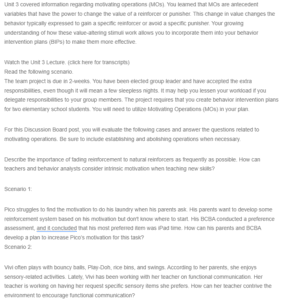Motivating Operations
The importance of fading reinforcement to natural reinforcement is to assist the child in learning how to adapt and use the behavior or skill more often to maintain their behavior for a long time since the fading reinforcement reinforces the child’s behavior with more available reinforcers such as natural consequences and praise (Page et al., 2022). In traditional societies, behavior analysts and teachers depended on controlling approaches for curriculum development and teaching. According to research studies, students under controlling directive conditions performed considerably worse than those under no controlling directive conditions (Orsini et al., 2015). In addition, students were more comfortable when they were in charge of their own behaviors. Therefore, behavior analysts and teachers can consider intrinsic motivation by giving students choices of learning methods, tasks, and exercises (Kusurkar et al., 2011). This is because an environment that gives children freedom and choices also requires them to be more responsible in their learning phases, thus stimulating their motivation.
Based on this argument, considering the first case scenario of Pico struggling to find the motivation to do laundry, BCBA and his parents must first let Pico know what is expected of him at the end of the week or month. This will allow Pico to decide when he will devote energy and time to doing laundry and his iPad. His parents must acknowledge his interests first and not dictate when he should do laundry. They can acknowledge Pico’s interests by suggesting that he listen to his favorite shows or music playing in the background as he does laundry. Pico’s parents can ask Pico what he would like to do and not tell him what to do and allow him to share his views, curiosity, and questions about doing laundry.
In the second case scenario, first, the teacher needs to interact with Vivi more humanly. According to Orsini et al. (2015), teachers have the basic role of creating rapport with students. The personal qualities of teachers are more crucial in motivating the students than the classroom or teaching methods and management practices (Brewer & Burgess, 2005). To promote functional communication, the teacher can lay the grounds for open-mindedness, accessibility, approachability, creativity, and a happy personality to allow Vivi to feel cared for and free to express herself without threats. When children feel emotionally supported and comfortable, they are more likely to express their views and opinions, making them more interested in the tasks they are taking on.
References
Brewer, E. W., & Burgess, D. N. (2005). Professor’s role in motivating students to attend class. Journal of STEM Teacher Education, 42(3), 3.
Kusurkar, R. A., Croiset, G., & Ten Cate, O. T. J. (2011). Twelve tips to stimulate intrinsic motivation in students through autonomy-supportive classroom teaching derived from self-determination theory. Medical teacher, 33(12), 978-982.
Orsini, C., Evans, P., & Jerez, O. (2015). How to encourage intrinsic motivation in the clinical teaching environment?: a systematic review from the self-determination theory. Journal of educational evaluation for health professions, 12.
Page, A.C., Stritzke, W.G.K., & McEvoy, P.M. (2022). Clinical Psychology for Trainees, Third Edition. New York: Cambridge University Press.
ORDER A PLAGIARISM-FREE PAPER HERE
We’ll write everything from scratch
Question
Unit 3 covered information regarding motivating operations (MOs). You learned that MOs are antecedent variables that have the power to change the value of a reinforcer or punisher. This change in value changes the behavior typically expressed to gain a specific reinforcer or avoid a specific punisher. Your growing understanding of how these value-altering stimuli work allows you to incorporate them into your behavior intervention plans (BIPs) to make them more effective.

Motivating Operations
Watch the Unit 3 Lecture. (click here for transcripts)
Read the following scenario.
The team project is due in 2-weeks. You have been elected group leader and have accepted the extra responsibilities, even though it will mean a few sleepless nights. It may help you lessen your workload by delegating responsibilities to your group members. The project requires that you create behavior intervention plans for two elementary school students. You will need to utilize Motivating Operations (MOs) in your plan.
For this Discussion Board post, you will evaluate the following cases and answer the questions about motivating operations. Be sure to include establishing and abolishing operations when necessary.
Describe the importance of fading reinforcement to natural reinforcers as frequently as possible. How can teachers and behavior analysts consider intrinsic motivation when teaching new skills?
Scenario 1:
Pico struggles to find the motivation to do his laundry when his parents ask. His parents want to develop some reinforcement system based on his motivation but don’t know where to start. His BCBA conducted a preference assessment, concluding that his most preferred item was iPad time. How can his parents and BCBA develop a plan to increase Pico’s motivation for this task?
Scenario 2:
Vivi often plays with bouncy balls, Play-Doh, rice bins, and swings. According to her parents, she enjoys sensory-related activities. Lately, Vivi has been working on functional communication with her teacher. Her teacher is working on having her request specific sensory items she prefers. How can her teacher contrive the environment to encourage functional communication?

